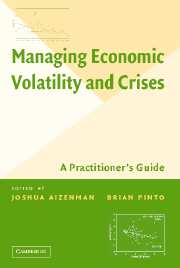Crossref Citations
This Book has been
cited by the following publications. This list is generated based on data provided by Crossref.
2004.
World Economic Outlook, April 2005: Globalization and External Balances.
2005.
Central America: Global Integration and Regional Cooperation.
García-Herrero, Alicia
and
Vilarrubia, Josep M.
2005.
The Laffer Curve of Macroeconomic Volatility and Growth: Can it be Explained by the Different Nature of Crises?.
SSRN Electronic Journal,
2005.
World Economic Outlook, April 2005: Globalization and External Imbalances.
Kose, M. Ayhan
Prasad, Eswar S.
and
Terrones, Marco E.
2006.
How do trade and financial integration affect the relationship between growth and volatility?.
Journal of International Economics,
Vol. 69,
Issue. 1,
p.
176.
Hirata, Hideaki
Kim, Sunghyun Henry
and
Kose, M. Ayhan
2007.
Sources of Fluctuations: The Case of MENA.
Emerging Markets Finance and Trade,
Vol. 43,
Issue. 1,
p.
5.
Bourguignon, François
2007.
Stabilité, sécurité et développement : une introduction.
Revue d'économie du développement,
Vol. Vol. 14,
Issue. 4,
p.
5.
Diebold, Francis X.
and
Yilmaz, Kamil
2008.
Macroeconomic Volatility and Stock Market Volatility, World-Wide.
SSRN Electronic Journal,
Cuberes, David
and
Jerzmanowski, Michał
2009.
Democracy, Diversification and Growth Reversals.
The Economic Journal,
Vol. 119,
Issue. 540,
p.
1270.
Voth, Hans-Joachim
2009.
The Sustainable Debts of Philip II: A Reconstruction of Spain's Fiscal Position, 1560-1598.
SSRN Electronic Journal,
Cavallo, Eduardo A.
Galindo, Arturo José
Izquierdo, Alejandro
and
Leon, John Jairo
2010.
The Role of Relative Price Volatility in the Efficiency of Investment Allocation.
SSRN Electronic Journal,
International Monetary Fund
2010.
The Cyclicality of Fiscal Policy in the Middle East and Central Asia:Is the Current Crisis Different?.
IMF Working Papers,
Vol. 10,
Issue. 68,
p.
1.
Drelichman, Mauricio
and
Voth, Hans-Joachim
2010.
The Sustainable Debts of Philip II: A Reconstruction of Castile's Fiscal Position, 1566–1596.
The Journal of Economic History,
Vol. 70,
Issue. 4,
p.
813.
ANNICCHIARICO, BARBARA
CORRADO, LUISA
and
PELLONI, ALESSANDRA
2011.
LONG‐TERM GROWTH AND SHORT‐TERM VOLATILITY: THE LABOUR MARKET NEXUS*.
The Manchester School,
Vol. 79,
Issue. s1,
p.
646.
Sutherland, Douglas
and
Hoeller, Peter
2013.
Growth-Promoting Policies and Macroeconomic Stability.
SSRN Electronic Journal,
d'Hôtel, Elodie Maître
Le Cotty, Tristan
and
Jayne, Thom
2013.
Trade Policy Inconsistency and Maize Price Volatility: An ARCH Approach in Kenya.
African Development Review,
Vol. 25,
Issue. 4,
p.
607.
Ossowski, Rolando
2013.
The International Handbook of Public Financial Management.
p.
513.
Rensburg, Dirk Jakobus Janse van
and
Pretorius, Leon
2014.
Managing for Volatility on Technology Projects: A Conceptual Model.
Procedia - Social and Behavioral Sciences,
Vol. 110,
Issue. ,
p.
40.
Cariolle, Joël
and
Goujon, Michaël
2015.
MEASURING MACROECONOMIC INSTABILITY: A CRITICAL SURVEY ILLUSTRATED WITH EXPORTS SERIES.
Journal of Economic Surveys,
Vol. 29,
Issue. 1,
p.
1.
Alhaji Jibrilla, Aliyu
and
Elliott, Caroline
2016.
Fiscal sustainability in the presence of structural breaks: Does overconfidence on resource exports hurt government’s ability to finance debt? Evidence from Nigeria.
Cogent Economics & Finance,
Vol. 4,
Issue. 1,
p.
1170317.



